Despite the variety of wireless information transfer technologies, they are essentially characterized by only three parameters: speed, range, and energy. Our world is structured in such a way that you can only improve two of these parameters at a time. It's like an elastic ring - when you pull on the ends, it stretches, but the pieces remain pressed together in the center. In LPWAN networks, the range and energy are stretched to the limit - sensors can transmit signals over tens of kilometers and operate for up to 10 years on a single battery. We pay for this with the transmission rate, which becomes very small, allowing us to transmit only bits of useful information, but very far. This may seem like a small amount, but it is sufficient to transmit an alarm signal or a parameter measured by a digital sensor.
There are many calculators on the Internet for calculating the theoretical range of radio communication. In real life, without a calculator, the range of operation depends directly on the terrain, the presence of interference, and the height of the receiving antenna. By the way, it is critical for LPWAN to place the antenna as high as possible. The signal from the sensor often arrives at the antenna not directly, but after multiple reflections from other objects. This is especially true in cities, where high-rise buildings, cars, trees, and other objects can interfere with the signal.
Let's give you a few examples from real projects. Our office is located in the Yuzhnaya metro station in Moscow, and a receiving antenna is installed on the roof of a 15-storey building. Moscow has a hilly terrain, with lower elevations in the north and higher elevations in the south. As a result, in good weather, you can see almost the entire city from the roof, including the Ostankino TV Tower. On the other side, in Biryulyovo, a couple of kilometers away, the roof is level with the ground. This should completely block the signals. However, due to reflections, the signals can reach the receiver. As you can see, our record in real life in Moscow is 178 km.

This is a lot, especially considering the terrain, and it's more of an exception to the rule than a real-life scenario. However, other examples, such as the 78-kilometer journey from the Istrinsky District in the Moscow Region or the 42-kilometer journey from Sheremetyevo Airport across the city, are also impressive. Additionally, LPWAN signals have excellent penetration capabilities, allowing them to pass through walls and even through the ground, but we will discuss this in a separate article.



